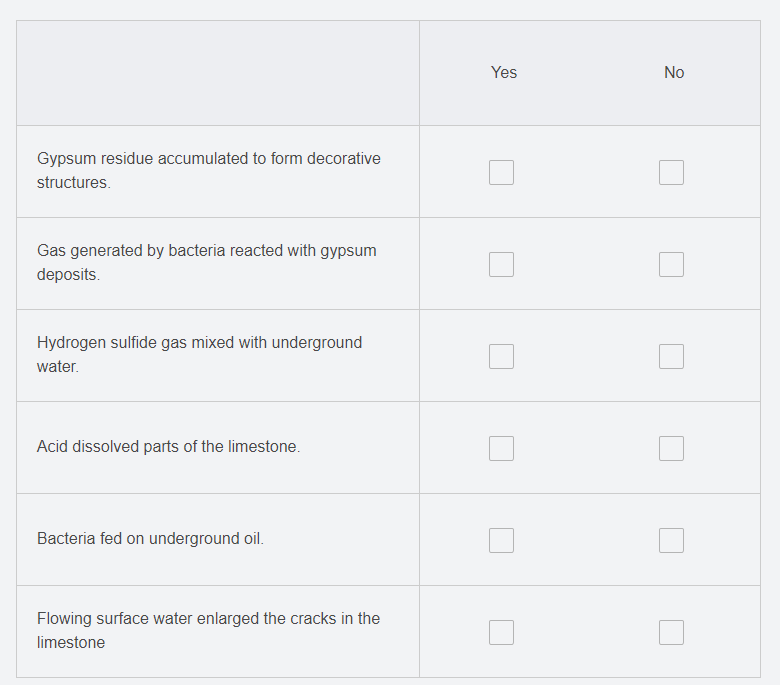2022-07-03 14:37:21 来源:中国教育在线
Lechuguilla Cave托福听力原文翻译及问题答案
一、Lechuguilla Cave托福听力原文:
Narrator:Listen to part of a lecture in a geology class.
MALE PROFESSOR:Now,there are some pretty interesting caves in parts of the western United States,especially in national parks;there's one park that has over a hundred caves,including some of the largest ones in the world.One of the more interesting ones is called Lechuguilla Cave.Lechuguilla’s been explored a lot in recent decades.It's a pretty exciting place,I think.It was mentioned only briefly in your books,so can anyone remember what it said?Ellen?
Female Student:It's the deepest limestone cave in the U.S.MALE PROFESSOR:That’s right—it's one of the longest and deepest limestone caves not just in the country,but in the world.What else?Female Student:Well,it was formed because of sulfuric acid,right?
MALE PROFESSOR:That's it.Yeah,what happens is,you have deep,underground oil deposits.And there are bacteria...here,let me draw a diagram.
Part of the limestone rock layer is permeated by water from below.Those curly lines are supposed to be cracks in the rock.Below the water table and rock is oil.Bacteria feed on this oil,and release hydrogen sulfide gas.This gas,this hydrogen sulfide,rises up and mixes with oxygen in the underground water that sits in the cracks and fissures in the limestone.
And when hydrogen sulfide reacts with the oxygen in the water,the result of that is sulfuric acid.OK?Sulfuric acid eats away at limestone—very aggressively—so you get bigger cracks,and then passageways being formed along the openings in the rock.And it's all underground.Yes,Paul?
Male student:So that water,it's not flowing,right?It’s still?
MALE PROFESSOR:Yes!So there’s two kinds of limestone caves.In about 90 percent of them,you have water from the surface,streams,waterfall,or whatever.Moving water that flows through cracks found in the limestone.It’s the moving water itself that wears away at the rock and makes passageways.
Also,in surface water,there's a weak acid,carbonic acid—not sulfuric acid,but carbonic acid,that helps dissolve the rock.With a little help from this carbonic acid,moving water forms most of the world’s limestone caves.
When I was researching this for a study a few years ago,I visited a couple of these typical limestone caves.They were all very wet,you know?From streams and rivers.This flowing water carved out the caves and the structures inside them.Male student:But not Lechuguilla?MALE PROFESSOR:Dry as a bone.Well,that might be a bit of an exaggeration,but it’s safe to say that it’s sulfuric acid,and not moving water,that formed Lechuguilla Cave,and those few other ones like it.In fact,there’s no evidence that flowing water has ever gone in or out of the cave.So it's like a maze,you have passageways all around.There're wide passages,narrow ones,at all different depths…like underground tunnels in the limestone.
And since they were created underground and not from flowing surface water,not all of these passageways have an opening to the outside world.And there’s other evidence that flowing water wasn't involved in Lechuguilla.We've said that sulfuric acid dissolves limestone,right?And forms the passageways?What else does sulfuric acid do?Paul.Male student:It leaves a chemical residue.Um,
Female Student:Gypsum,right?MALE PROFESSOR:Yep.You'll find lots of gypsum deposited at Lechuguilla.And,as we know,gypsum is soluble in water.So if there were flowing water in the cave,it would dissolve the gypsum.This is part of what led us to the realization that Lechuguilla is in that small group of waterless caves.And,Lechuguilla is pretty much dormant now.It's not really forming anymore…
but there's other ones like it,for example in Mexico,that are forming,and when cave researchers go to explore them,they see—and smell—the sulfuric acid and gases at work.Whew!It’s something else!Think of rotten eggs.And it's not just the smell.Explorers even need to wear special masks to protect themselves from the gases in these caves.OK.Paul?Male student:Yeah,how about what these caves look like,uh,on the inside?
MALE PROFESSOR:Oh,well,the formations are something.And there's such a variety there,like nothing anywhere else in the world!Some of them are elaborate-looking,like decorations.And a lot of them are made of gypsum,and can be up to twenty feet long.It's pretty impressive.
二、Lechuguilla Cave托福听力中文翻译:
旁白:听地质学课上的一节课。
男教授:现在,在美国西部的一些地方,特别是在国家公园,有一些非常有趣的洞穴;有一个公园有一百多个洞穴,其中包括一些世界上最大的洞穴。其中一个更有趣的洞穴叫做Lechuguilla洞穴。近几十年来,人们对Lechuguilla进行了大量探索。我认为这是一个非常令人兴奋的地方。你的书中只简要提到过它,所以有人记得它说了什么吗?艾伦?
女学生:这是美国最深的石灰岩洞穴。男教授:是的,它不仅是美国,而且是世界上最长最深的石灰岩洞穴之一。还有什么?女生:嗯,它是因为硫酸而形成的,对吗?
男教授:就是这样。是的,发生的是,你有很深的地下石油储量。还有细菌。。。这里,让我画一个图表。
石灰岩岩层的一部分被下面的水渗透。那些卷曲的线条应该是岩石上的裂缝。地下水位和岩石下面是石油。细菌以这种油为食,并释放硫化氢气体。这种气体,这种硫化氢,上升并与石灰岩裂缝中的地下水中的氧气混合。
当硫化氢与水中的氧气反应时,其结果就是硫酸。好啊硫酸对石灰石的侵蚀非常剧烈,因此会产生更大的裂缝,然后沿着岩石开口形成通道。而且都在地下。什么事,保罗?
男学生:那么水,它不会流动,对吗?还是这样?
男教授:是的!这里有两种石灰岩洞穴。大约90%的水来自地表、溪流、瀑布或其他地方。流经石灰岩裂缝的流动水。是流动的水本身侵蚀了岩石,形成了通道。
此外,在地表水中,有一种弱酸,碳酸不是硫酸,而是碳酸,有助于溶解岩石。在这种碳酸的帮助下,流动的水形成了世界上大部分的石灰岩洞穴。
几年前,当我为一项研究而对此进行研究时,我参观了几个典型的石灰岩洞穴。他们都很湿,你知道吗?来自溪流和河流。这些流动的水雕刻出洞穴及其内部的结构。男学生:但不是Lechuguilla?男教授:干巴巴的。嗯,这可能有点夸张,但可以肯定地说,是硫酸,而不是流动的水,形成了Lechuguilla洞穴,以及其他几个类似的洞穴。事实上,没有证据表明流动的水曾经进出过洞穴。这就像一个迷宫,四周都有通道。有宽的通道,狭窄的通道,在所有不同的深度…就像石灰岩中的地下隧道。
由于这些通道是在地下建造的,而不是从流动的地表水中建造的,因此并非所有这些通道都向外部世界开放。还有其他证据表明,流淌的水与Lechuguilla无关。我们说过硫酸溶解石灰石,对吗?形成通道?硫酸还能做什么?保罗。男学生:它会留下化学残留物。嗯;
女生:石膏吧?男教授:是的。你会发现很多石膏沉积在Lechuguilla。正如我们所知,石膏可溶于水。因此,如果洞穴中有流动的水,它会溶解石膏。这是导致我们认识到Lechuguilla在那一小群无水洞穴中的部分原因。而且,Lechuguilla现在几乎处于休眠状态。它不再真正形成…
但还有其他类似的洞穴正在形成,例如在墨西哥,当洞穴研究人员去探索它们时,他们会看到并闻到硫酸和气体的气味。呼!这是另外一回事!想想臭鸡蛋。这不仅仅是气味。探险者甚至需要戴上特殊的口罩来保护自己免受这些洞穴中的气体的伤害。好啊保罗?男学生:是的,这些洞穴里面看起来像什么?
男教授:哦,好吧,队形是很重要的。世界上其他地方都没有这样的品种!其中一些看起来很精致,像装饰品。其中很多都是由石膏制成的,可以长达20英尺。这真令人印象深刻。
三、Lechuguilla Cave托福听力问题:
Q1:1.What is the main purpose of the lecture?
A.To explain the various ways that sulfuric acid is involved in the formation of caves
B.To describe caves and other geologic formations in U.S.national parks
C.To use Lechuguilla Cave as an example of how most caves form
D.To discuss the formation and characteristics of an unusual type of cave
Q2:2.The professor mentions parts of the process involved in the formation of Lechuguilla Cave.Indicate which of the statements below describe part of the process.[Click in the correct boxes.This question is worth 2 points.]

Q3:3.According to the professor,what substance found in surface water is important for the formation of typical limstone caves?
A.Gypsum.
B.Oxygen.
C.Carbonic acid.
D.Sulfuric acid.
Q4:4.What does the presence of gypsum in Lechuguilla Cave indicate?
A.The cave was not formed by flowing water.
B.The cave is no longer forming.
C.Bacteria are present in high concentrations inside the cave.
D.No type of acid was involved in the formation of the cave.
Q5:5.What can be inferred from thefact that Lechuguilla Cave is no longer forming?
A.The cave has stopped attracting visitors.
B.The cave no longer contains any limestone.
C.The air in the cave is safer to breathe now than it was in the past.
D.Gypsum deposits inside the cave are growing thicker.
Q6:6.What does the professor mean when he says this:
A.Lechuguilla Cave is not completely absent of water.
B.Lechuguilla Cave is not totally safe to explore.
C.Water long ago flowed through Lechuguilla Cave.
D.Scientists do not agree about how Lechuguilla Cave was formed.
四、Lechuguilla Cave托福听力答案:
A1:正确答案:D
A2:正确答案:ABAAAB
A3:正确答案:C
A4:正确答案:A
A5:正确答案:C
A6:正确答案:A


(一)由于考试政策等各方面情况的不断调整与变化,本网站所提供的考试信息仅供参考,请以权威部门公布的正式信息为准。
(二)本网站在文章内容来源出处标注为其他平台的稿件均为转载稿,免费转载出于非商业性学习目的,版权归原作者所有。如您对内容、版 权等问题存在异议请与本站联系,我们会及时进行处理解决。"